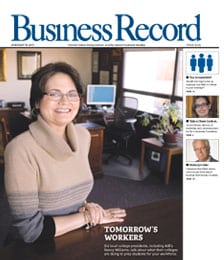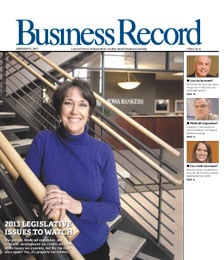Des Moines cultural districts see hope in state program

In recent years, the cards appeared to have been stacked against the retailers, restaurants and entertainment venues in the Roosevelt High School neighborhood. Rapid development in the western suburbs drew shoppers elsewhere, construction temporarily shut down freeway access to the district, and an economic downturn in 2001 hit most business owners below the belt.
But a statewide program is shining a light at the end of the tunnel for business people such as Sheena Thomas, owner of Elements Ltd. in the Shops at Roosevelt, who believes that the neighborhood’s potential designation as a cultural and entertainment district (CED) will not only be a marketing tool, but also a means of attracting resources and financing to advance revitalization and future development efforts.
“As we were talking about what a CED needed, I thought, ‘We’re it. We’re all those things that they’re saying we need to be,’” Thomas said. “We have a major cultural attraction in the (Des Moines) Playhouse, the named historical structure in Roosevelt High School, two schools that are really strong with art, music and drama, four art galleries and several shops that are either supporting or related to the arts. We just needed to get our act together and start communicating.”
The Roosevelt district is one of three in the city and 13 in the state that have requested CED certification from the state of Iowa through a program that is still in its infancy. The Cultural and Entertainment District Advisory Committee certified its first round of districts just one year ago. But as the second state to establish such a program, Iowa is setting an example for the rest of the country of what such efforts can do to promote the often hidden or forgotten jewels a state has to offer its residents and visitors.
“This does put Iowa on the cutting edge on creative economy,” said Anita Walker, director of the Iowa Department of Cultural Affairs.
Maryland, the first state to establish CED certification, is just now beginning to collect data on its cultural and entertainment districts, which has provided further encouragement to program developers in Iowa. About three years into its program, Maryland has seen an increase in retail spending, employment, housing and general economic development emerging from its CEDs, considered compact areas of a city anchored by a high concentration of cultural facilities.
That’s exactly what the city of Des Moines is hoping for, as three areas within its boundaries – the Roosevelt Cultural District, the Court Avenue district and the East Village – have worked with city officials to apply for CED certification.
“I think Des Moines is always recognized as a good employment center, we have a lot of things going on, but I don’t think some cities think of us as having a lot of cultural opportunities,” said senior city planner Mary Neiderbach. “It wakes people up to Des Moines as a center for the arts and entertainment.”
The CED program was created in 2004 as part of the Grow Iowa Values Fund bill, but the veto of that legislation eliminated financial incentives for last year’s batch of certified districts – located in Cedar Falls, Charles City, Cherokee, Davenport, Dubuque, Iowa City, Muscatine and Spencer – which received nothing more than a handshake and a pat on the back.
But changes to that legislation during the 2005 session allowed for $40 million in historic preservation tax credits to be earmarked for the program over the next 10 years. The tax credits will be available for the rehabilitation of historic buildings. Other incentives will be available for the creation of live/work spaces for artists and space for cultural and entertainment enterprises.
“We know that areas with a high concentration of arts and historic buildings attract a highly educated and diverse workforce and tourists who support additional businesses such as restaurants, hotels and entertainment venues,” Walker said. “The result is a synergy that increases property values, profitability and the tax base of the region.”
The Iowa Department of Cultural Affairs is brainstorming a financial package to propose during the 2006 legislative session. Walker said the program will require evaluation in the future to determine what tools and incentives will make a difference within those CEDs.
For now, leaders within the East Village and the Court Avenue district are eyeing those tax credits to help finance ongoing and planned restoration and development of several historic buildings. Not all of these buildings are in a state of disrepair, but nonetheless would receive a boost toward development and maintenance.
“Those individuals who have historic property, they’re going to benefit the most,” said Kit Curran, president of Historic East Village Inc. “But it’s really as a whole to help this area flourish. Whoever the individuals are who own the properties, it’s only going to help everyone.”
In the Court Avenue district, developers such as Harry Bookey and Jim Hubbell have already received consideration for tax credits to develop and revitalize areas of the neighborhood. But Mike Utley, assistant general manager of Court Avenue Brewing Co. and co-chair of the Court Avenue Association, believes the CED program’s tax credit plan “attracts the little guy and gives him a little bit of a break to come into a new area that’s starting to take on a life of its own and gives people a chance to get in.”
In addition to tax credits, CEDs will receive signage within the district and on nearby interstate highways and will be highlighted on state and regional maps, all of which are seen as a huge boost by those who have spearheaded these efforts.
The districts that have applied to the state also remain hopeful that, if awarded CED designation, they will have access to financial assistance from state agencies and the program’s funding partners for projects such as beautification efforts in the East Village or promotion of events in the Roosevelt Cultural District.
In the Court Avenue district, which covers areas from the Des Moines River to Seventh Street and Principal Park to Locust Street, Utley said the association has considered projects related to Nollen Plaza and new downtown housing projects, as well as streetscape efforts. Many in the district have also supported an effort to light the exterior of the Polk County Courthouse.
“It’s kind of the beacon of our area,” Utley said.
Walker added that “the mere establishment of a cultural district…is a fuel in and of itself to help with the revitalization process.”
“It’s a wonderful fuel for economic development, a way to attract people and a way to revitalize parts of cities and towns,” she said.
The city of Des Moines has played a critical role in moving these applications forward and into the hands of the Cultural and Entertainment District Advisory Committee, which will vote on the applications next month. To be eligible, a district must vow participation for three years, with an option to renew the certification, and the city must make a 10-year commitment, financial and otherwise.
“We really feel strongly that we need to have a long-term commitment by city leaders, that they back this and they are going to be a part of helping develop these districts,” Walker said. “It’s a combination of everything from how they position the cultural district within city planning efforts to financial incentives.”
Neiderbach said the city council held a special workshop this year to discuss the CED applicants, and to ensure caution in how the city proceeded with not one but three applicants, particularly in light of limited resources and staff. But the city has backed all three proposals and plans to move full steam ahead with any and all districts that receive CED certification.
Though city support does not strictly entail financial support, Neiderbach said the designation could speed up the existing time frame of proposed projects for those areas, such as a bicycle and pedestrian trail through the Roosevelt Cultural District.
“The big benefit is pushing people toward our area,” Thomas said of the efforts.
The city has also encouraged that district in particular to consider establishing a self-supporting municipal improvement district, which would generate tax revenues to fund maintenance and improvement of public spaces.
This is Des Moines’ second crack at establishing one or more CEDs within the city after the Capital East Business District failed to receive approval from the committee last year.
“I was disappointed because I thought we had a good application, and I always like to see a district renovated with historic buildings in mind,” Neiderbach said. “I think (the committee) felt that (the district wasn’t) ready yet and did not have enough going on. There is more going on in that area, but we just weren’t ready and didn’t have enough groundwork that had been laid.”
She believes Capital East will pursue CED certification again in the future, and also sees potential for several other areas in Des Moines to become CEDs, including Beaverdale and the Ingersoll Avenue neighborhood.
But this year’s efforts, while still time consuming, were easier the second time around, and Neiderbach believes the districts have submitted strong applications spurred by grassroots efforts from within the districts themselves.
“The East Village, with all the development that is occurring and the very strong historical base, could certainly make use of the tax credits,” she said. “Court Avenue has been the entertainment district for a long time, and this could be the shot in the arm to do more things. And in (the Roosevelt district), with the high school, the different retail stores that are there, the Playhouse, all combined really give you a lot of synergy.”







